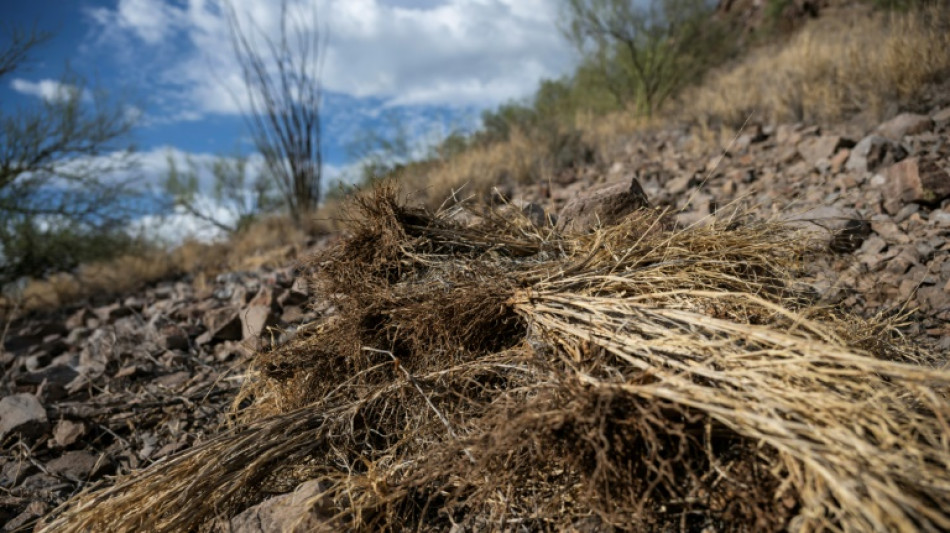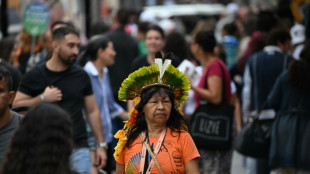
-
 Mushroom houses for Gaza? Arab designers offer home-grown innovations
Mushroom houses for Gaza? Arab designers offer home-grown innovations
-
Gabon votes on new constitution hailed by junta as 'turning point'

-
 Young Libyans gear up for their first ever election
Young Libyans gear up for their first ever election
-
Vice tightens around remaining civilians in eastern Ukraine

-
 Dutch coalition survives political turmoil after minister's resignation
Dutch coalition survives political turmoil after minister's resignation
-
Uruguay end winless run with dramatic late win over Colombia

-
 Max potential: 10 years since a teenage Verstappen wowed in Macau
Max potential: 10 years since a teenage Verstappen wowed in Macau
-
Tens of thousands flee as Typhoon Man-yi nears Philippines

-
 Is Argentina's Milei on brink of leaving Paris climate accord?
Is Argentina's Milei on brink of leaving Paris climate accord?
-
Big Bang: Trump and Musk could redefine US space strategy

-
 Revolution over but more protests than ever in Bangladesh
Revolution over but more protests than ever in Bangladesh
-
Minister resigns but Dutch coalition remains in place

-
 Ireland won 'ugly', says relieved Farrell
Ireland won 'ugly', says relieved Farrell
-
Stirring 'haka' dance disrupts New Zealand's parliament

-
 England's Hull grabs lead over No.1 Korda at LPGA Annika
England's Hull grabs lead over No.1 Korda at LPGA Annika
-
Kosovo players walk off in Romania after 'Serbia' chants, game abandoned

-
 Kosovo players walk off in Romania game after 'Serbia' chants
Kosovo players walk off in Romania game after 'Serbia' chants
-
Lame-duck Biden tries to reassure allies as Trump looms

-
 Nervy Irish edge Argentina in Test nailbiter
Nervy Irish edge Argentina in Test nailbiter
-
Ronaldo at double as Portugal reach Nations League quarters, Spain win

-
 Fitch upgrades Argentina debt rating amid economic pain
Fitch upgrades Argentina debt rating amid economic pain
-
Trump picks Doug Burgum as energy czar in new administration

-
 Phone documentary details struggles of Afghan women under Taliban
Phone documentary details struggles of Afghan women under Taliban
-
Ronaldo shines as Portugal rout Poland to reach Nations League last-eight

-
 Spain beat Denmark to seal Nations League group win
Spain beat Denmark to seal Nations League group win
-
Former AFCON champions Ghana bow out as minnows Comoros qualify

-
 Poland, Britain reach BJK Cup quarter-finals
Poland, Britain reach BJK Cup quarter-finals
-
At summit under Trump shadow, Xi and Biden signal turbulence ahead

-
 Lebanon said studying US truce plan for Israel-Hezbollah war
Lebanon said studying US truce plan for Israel-Hezbollah war
-
Xi warns against 'protectionism' at APEC summit under Trump cloud

-
 Nigerian UN nurse escapes jihadist kidnappers after six years
Nigerian UN nurse escapes jihadist kidnappers after six years
-
India in record six-hitting spree to rout South Africa

-
 George tells England to prepare for rugby 'war' against Springboks
George tells England to prepare for rugby 'war' against Springboks
-
Pogba's Juve contract terminated despite doping ban reduction

-
 Ukraine slams Scholz after first call with Putin in two years
Ukraine slams Scholz after first call with Putin in two years
-
Michael Johnson's Grand Slam Track series to have LA final

-
 Kagiyama, Yoshida put Japan on top at Finland Grand Prix
Kagiyama, Yoshida put Japan on top at Finland Grand Prix
-
Alcaraz eyeing triumphant Davis Cup farewell for Nadal after ATP Finals exit

-
 Xi, Biden at Asia-Pacific summit under Trump trade war cloud
Xi, Biden at Asia-Pacific summit under Trump trade war cloud
-
India go on record six-hitting spree against South Africa

-
 France skipper Dupont says All Blacks 'back to their best'
France skipper Dupont says All Blacks 'back to their best'
-
Trump pressures US Senate with divisive cabinet picks

-
 Bagnaia strikes late in Barcelona practice to edge title rival Martin
Bagnaia strikes late in Barcelona practice to edge title rival Martin
-
High-ball hero Steward ready to 'front up' against South Africa

-
 Leader of Spain flood region admits 'mistakes'
Leader of Spain flood region admits 'mistakes'
-
Swiatek, Linette take Poland past Spain into BJK Cup quarter-finals

-
 Leftist voices seek to be heard at Rio's G20 summit
Leftist voices seek to be heard at Rio's G20 summit
-
Wales coach Jenkins urges players to 'get back on the horse'

-
 Zverev reaches ATP Finals last four, Alcaraz out
Zverev reaches ATP Finals last four, Alcaraz out
-
Boeing strike will hurt Ethiopian Airlines growth: CEO


Invasive firestarter: How non-native grasses turned Hawaii into a tinderbox
After a catastrophic wildfire that killed more than 100 people in Hawaii, eyes have turned toward an unexpected culprit: invasive grass species that have spread massively over the archipelago for decades, serving as the perfect fuel.
Drought-resistant, capable of invading difficult terrain, and gradually muscling out local species, they are also a growing threat in the western United States, where devastating fires are increasing.
"Invasive grasses are very ignitable. They change the landscape," Carla D'Antonio, a professor of ecology at the University of California, Santa Barbara told AFP.
"They make conditions that are more conducive to more fire, and all of a sudden, we just have a lot more fire."
Rather than decomposing when they die, they stay "standing there for a long time, dry as a bone," said D'Antonio, who has been studying these species for more than 30 years. They're also hardy, surviving fires better than native species and gradually replacing them.
Most of these grasses -- buffelgrass, Guinea grass, molasses grass -- came from Africa, and were introduced as pasture for cattle, without knowing the danger they would come to represent decades later.
In Hawaii, the demise of sugar cane plantations in the 1990s as a result of globalization had disastrous consequences: huge tracts of land were abandoned, allowing the invasive species an opening.
"Yes, many parts of Hawaii are trending towards dryer conditions, but the fire problem is mostly attributable to the vast extents of non-native grasslands left unmanaged by large landowners as we've entered a 'post-plantation era,'" said Clay Trauernicht, a fire ecologist at the University of Hawaii at Manoa.
Trauernicht said the annual area burned in Hawaii has increased by 300 percent in recent decades.
A 2021 fire prevention report by Maui County described fires as a growing threat due to increasing temperatures and prolonged periods of drought as a result of climate change, and the growing menace of intrusive grasses.
Hawaii, despite its tropical reputation, is getting drier: a 2016 study found 90 percent of the state received less rain compared to a century earlier.
The Maui County report recommended "an aggressive plan to replace these hazardous fuel sources with native plants to reduce combustible fuel while increasing water retention."
- 'Nothing natural about it' -
The problem isn't confined to Hawaii. Over in the mainland United States, "the deserts of the West and the conifer forests, and then the shrub lands in the coastal zone, invasive grasses are here to stay, they're now part of the ecosystem," said D'Antonio.
She herself spends some Saturday evenings weeding roadsides with neighbors in a mountainous area near Santa Barbara, California. Their goal: to prevent a fire from starting from a cigarette butt or an overheating vehicle.
Most of the major fires of the Mojave and Great Basin have been fueled by invasive grasses, she says, while also citing the Camp Fire of 2018, which destroyed the small California town of Paradise, killing more than 80 people. It was started by a power line igniting dry grass.
"(I'm) not making the mistake of calling it a natural disaster because there's almost nothing natural about it," emphasizes the scientist.
One of the invaders, buffelgrass, also threatens the emblematic cactus of the Saguaro National Park in Arizona, by smothering young saguaros and fueling fires in the region. Organizations regularly organize clearing operations. The same species is spreading in Mexico and in Australia.
According to a 2019 study, six invasive grass species caused fire frequency to increase by up to 150 percent in US ecosystems.
For D'Antonio of UC Santa Barbara, tragedies like that of Hawaii are linked to many factors: the alteration of the landscape by humans, the invasion of alien species, droughts made worse by climate change, but also a lack of preparation.
In the American West, widespread logging of conifer forests in the 19th century and a long history of excessive fire suppression in the 20th century contributed to accumulation of tinder on the forest floor.
"The potential for disaster is huge," said D'Antonio, leaving society with daunting questions to address. "How do we plan for the extreme? Not for the average fire, but the extreme fire?"
K.Brown--BTB

